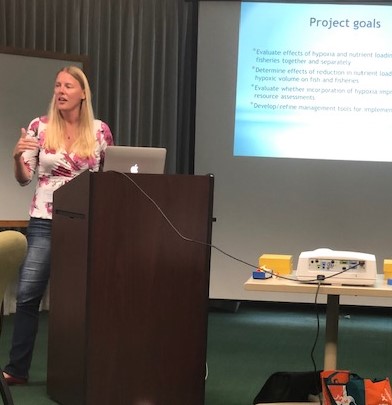
Building on results of an initial 2017 workshop, a second advisory panel workshop concerning the effects of low dissolved oxygen in water (hypoxia) was held June 24-25, 2019, in Miami, Florida. The workshop focused on introducing new user tools and training.
Expanding hypoxia in the northern Gulf of Mexico continues to affect ecologically and economically important living resources, but the magnitude, predictability and even the direction of these changes remain elusive. Managers and stakeholders need readily available and quantitative tools to predict and evaluate the effects on living resources of planned nutrient reduction strategies aimed to minimize the hypoxic zone. To resolve these uncertainties, NCCOS is sponsoring research on developing user-driven, management-relevant, tools to accurately predict and assess effects of reduced nutrients and hypoxia on living resources in the Gulf of Mexico.

At the workshop, approximately 16 attendees, including project PIs, Co-PIs, NOAA representatives, and Advisory Panel Members updated progress made on the NGOMEX project. Kicking off the discussion was a presentation of the results of an advisory panel opinion survey that included 12 responders from the advisory panel and other interested parties.
The opinion survey gathered more information about how to best serve managers and make sure that the outcomes/outputs of the model have the best chance of adoption or use for management decisions. One of the most important questions identified in the survey is determining how different nutrient loadings scenarios would affect Gulf productivity to inform fisheries management decisions.
Models reviewed at the workshop include hypoxia (hydrodynamic), bioenergetics, Ecospace (spatial), Ecopath, Ecosim, and a NGOMEX Ecospace model. The models will eventually support a user friendly, map-based management decision support tool. Living marine resource data considered for inclusion in the map-based management tool include mackerel, sea trout, red snapper, red drum, gulf menhaden, Atlantic croaker, blue crab, brown shrimp, white shrimp, zooplankton, and phytoplankton.
Future workshops will address space and time scaling, mean growth (fish and fish populations), behavior, model evaluation and sensitivity, other species, linking to ECOSIM/E$COSPACE food web models, linking to other data (e.g., Southeast Area Monitoring and Assessment Program or SEAMAP), and production estimates.
The workshop was organized by the Project Lead, Dr. Kim de Mutsert, and held at the University of Miami Rosenstiel School of Marine and Atmospheric Science.
For more information, contact David Hilmer.
